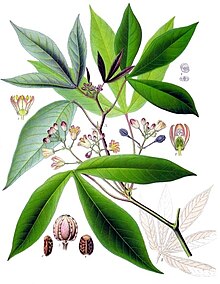
Back Broodwortel Afrikaans بفرة Arabic بفره ARZ Manihot esculenta AST Maniok Azerbaijani Kaséla BAN Balinghoy BCL Маніёк Byelorussian Маниока Bulgarian Maniok Bislama
| Cassava | |
|---|---|

| |

| |
| Tuber (waxed) | |
| Scientific classification | |
| Kingdom: | Plantae |
| Clade: | Tracheophytes |
| Clade: | Angiosperms |
| Clade: | Eudicots |
| Clade: | Rosids |
| Order: | Malpighiales |
| Family: | Euphorbiaceae |
| Genus: | Manihot |
| Species: | M. esculenta
|
| Binomial name | |
| Manihot esculenta | |
| Synonyms[1] | |
| |
Manihot esculenta, commonly called cassava, manioc, or yuca (among numerous regional names), is a woody shrub of the spurge family, Euphorbiaceae, native to South America, from Brazil, Paraguay and parts of the Andes. Although a perennial plant, cassava is extensively cultivated in tropical and subtropical regions as an annual crop for its edible starchy root tuber. Cassava is predominantly consumed in boiled form, but substantial quantities are processed to extract cassava starch, called tapioca, which is used for food, animal feed, and industrial purposes. The Brazilian farinha, and the related garri of West Africa, is an edible coarse flour obtained by grating cassava roots, pressing moisture off the obtained grated pulp, and finally drying it (and roasting in the case of both farinha and garri).
Cassava is the third-largest source of carbohydrates in food in the tropics, after rice and maize, making it an important staple; more than 500 million people depend on it. It offers the advantage of being exceptionally drought-tolerant, and able to grow productively on poor soil. The largest producer is Nigeria, while Thailand is the largest exporter of cassava starch.
Cassava is grown in sweet and bitter varieties; both contain toxins, but the bitter varieties have them in much larger amounts. Cassava has to be prepared carefully for consumption, as improperly prepared material can contain sufficient cyanide to cause poisoning. The more toxic varieties of cassava have been used in some places as famine food during times of food insecurity. Farmers may however choose bitter cultivars to minimise crop losses.
- ^ a b "Manihot esculenta Crantz, Rei Herb. 1: 167 (1766)". Plants of the World Online. Board of Trustees of the Royal Botanic Gardens, Kew. 2022. Archived from the original on 11 November 2022. Retrieved 11 November 2022.
© MMXXIII Rich X Search. We shall prevail. All rights reserved. Rich X Search